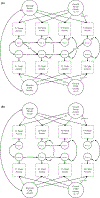Testing reciprocal associations between child anxiety and parenting across early interventions for inhibited preschoolers
- PMID: 37644651
- PMCID: PMC11289767
- DOI: 10.1111/jcpp.13879
Testing reciprocal associations between child anxiety and parenting across early interventions for inhibited preschoolers
Abstract
Background: Given the robust evidence base for the efficacy of evidence-based treatments targeting youth anxiety, researchers have advanced beyond efficacy outcome analysis to identify mechanisms of change and treatment directionality. Grounded in developmental transactional models, interventions for young children at risk for anxiety by virtue of behaviorally inhibited temperament often target parenting and child factors implicated in the early emergence and maintenance of anxiety. In particular, overcontrolling parenting moderates risk for anxiety among highly inhibited children, just as child inhibition has been shown to elicit overcontrolling parenting. Although longitudinal research has elucidated the temporal unfolding of factors that interact to place inhibited children at risk for anxiety, reciprocal transactions between these child and parent factors in the context of early interventions remain unknown.
Method: This study addresses these gaps by examining mechanisms of change and treatment directionality (i.e., parent-to-child vs. child-to-parent influences) within a randomized controlled trial comparing two interventions for inhibited preschoolers (N = 151): the multicomponent Turtle Program ('Turtle') and the parent-only Cool Little Kids program ('CLK'). Reciprocal relations between parent-reported child anxiety, observed parenting, and parent-reported accommodation of child anxiety were examined across four timepoints: pre-, mid-, and post-treatment, and one-year follow-up (NCT02308826).
Results: Hypotheses were tested via latent curve models with structured residuals (LCM-SR) and latent change score (LCS) models. LCM-SR results were consistent with the child-to-parent influences found in previous research on cognitive behavioral therapy (CBT) for older anxious youth, but only emerged in Turtle. LCS analyses revealed bidirectional effects of changes in parent accommodation and child anxiety during and after intervention, but only in Turtle.
Conclusion: Our findings coincide with developmental transactional models, suggesting that the development of child anxiety may result from child-to-parent influences rather than the reverse, and highlight the importance of targeting parent and child factors simultaneously in early interventions for young, inhibited children.
Keywords: Early intervention; anxiety; parenting; temperament.
© 2023 The Authors. Journal of Child Psychology and Psychiatry published by John Wiley & Sons Ltd on behalf of Association for Child and Adolescent Mental Health.
Conflict of interest statement
Conflict of interest statement: No conflicts declared.
Figures




References
-
- Bentler PM (1990). Comparative fit indexes in structural models. Psychological Bulletin, 107, 38–246. - PubMed
-
- Berry D, & Willoughby MT (2017). On the practical interpretability of cross-lagged panel models: Rethinking a developmental workhorse. Child Development, 88, 1186–1206. - PubMed
-
- Bishop G, Spence SH, & McDonald C. (2003). Can parents and teachers provide a reliable and valid report of behavioral inhibition? Child Development, 74, 1899–1917. - PubMed
Publication types
MeSH terms
Associated data
Grants and funding
LinkOut - more resources
Full Text Sources
Medical
Research Materials

